Positron
Composition :
Statistics :
Generation :
Family :
Interaction forces :
Symbol :
Antiparticle :
Mass :
Decays into :
Electric charge :
Color charge
Spin :
Weak isospin :
Elementary antiparticle
Fermionic
First
Lepton
weak, electromagnetic,
gravity
e⁺
Electron ( e )
0.5109989461(13) MeV/c²
1 e
none
¹/₂
LH: 0; RH : ¹/₂
POSITRON
General
Positrons are subatomic particles that are the antimatter counterpart of electrons. They have the same mass as electrons but carry a positive electric charge, as opposed to the negative charge of electrons. Here are some key characteristics and properties of positrons:
Charge: Positrons have a positive electric charge, which is exactly equal in magnitude to the charge of an electron but with the opposite sign. The charge of a positron is approximately +1 elementary charge (e), where the elementary charge (e) is about +1.602 x 10^-19 coulombs.
Mass: Positrons have the same mass as electrons. Their mass is approximately 9.109 x 10^-31 kilograms, making them very lightweight particles.
Antiparticle: Positrons are considered antimatter particles because they have properties that are opposite to those of electrons. When a positron encounters an electron, they can annihilate each other, releasing energy in the form of gamma rays. This annihilation process is a well-known example of matter-antimatter interaction.
Production: Positrons can be produced in various ways, including through certain types of radioactive decays, as a result of high-energy particle collisions, and in laboratory settings using particle accelerators.
Applications: Positrons have important applications in various fields, such as medical imaging. In positron emission tomography (PET), positron-emitting isotopes are used to create images of the internal structures and functions of the human body.
Antiparticles: Positrons are just one example of antimatter particles. Many subatomic particles have corresponding antiparticles with opposite charge. When a particle encounters its antiparticle, they can annihilate each other, converting their mass into energy according to Einstein's famous equation, E=mc².
Positrons are relatively rare in the universe compared to electrons, which are abundant in atoms and molecules. They are important in the study of particle physics, antimatter research, and medical diagnostics, particularly in the field of PET imaging. The existence of antimatter, including positrons, is a fascinating aspect of the fundamental nature of particles and their interactions in the universe.
Quantum States of positrons: Positrons, like electrons, also have quantum states that are described by a set of quantum numbers. These quantum numbers specify various properties of the positron's state, including its energy, angular momentum, and spin. The possible quantum states of a positron are analogous to those of an electron, but with some important differences due to the opposite charge (positively charged) of the positron. Here are the quantum numbers for positrons:
Principal Quantum Number (n): The principal quantum number, denoted as "n," determines the energy level or shell of the positron's state, just like in electrons. It can have positive integer values (1, 2, 3, ...) representing different energy levels. Higher values of n correspond to higher energy levels, which are farther from the nucleus.
Angular Momentum Quantum Number (l): The angular momentum quantum number, denoted as "l," specifies the shape of the positron's orbital within an energy level, similar to electrons. It can have integer values from 0 to (n-1), defining different subshells:
l = 0 corresponds to an s orbital (spherical shape).
l = 1 corresponds to a p orbital (dumbbell-shaped).
l = 2 corresponds to a d orbital (more complex shapes).
l = 3 corresponds to an f orbital (even more complex shapes).
And so on for higher values of l.
Magnetic Quantum Number (mₗ): The magnetic quantum number, denoted as "mₗ," specifies the orientation or direction of the positron's orbital within a subshell, just like in electrons. It can have integer values ranging from -l to +l, including zero. Each value of mₗ corresponds to a specific spatial orientation of the orbital.
Spin Quantum Number (s): The spin quantum number, denoted as "s," describes the intrinsic angular momentum or spin of the positron, similar to electrons. It can have one of two values: +1/2 (spin "up") or -1/2 (spin "down"). The spin quantum number distinguishes between the two possible spin states of a positron.
It's important to note that while positrons and electrons share similar quantum numbers, their opposite charges lead to significant differences in their behavior and interactions with matter. Positrons are antimatter particles, and when they encounter electrons, they can annihilate each other, releasing energy in the process.
Combinations with positrons
Particles composed of at least one positron typically involve antimatter, as a positron is the antimatter counterpart of the electron. Antiparticles have the same mass as their corresponding particles but carry opposite electric charges. Here's an overview of particles that involve positrons:
Positronium (Ps): Positronium is a bound state of an electron and a positron. It can exist in two forms: para-positronium (with the spins of the electron and positron antiparallel) and ortho-positronium (with the spins parallel). Positronium is unstable and annihilates into two or more gamma-ray photons shortly after formation.
Antiprotonic Hydrogen (p̄H): Antiprotonic hydrogen (or Protonium) is a system consisting of an antiproton orbiting a hydrogen nucleus (proton). In certain experiments, the antiproton replaces the electron, forming an exotic atom.
Positronium-like Ions: In some extreme conditions, such as in high-energy astrophysical environments or laboratory experiments, positronium-like ions may form, involving positrons interacting with other particles.
It's important to note that antimatter particles, including those involving positrons, are typically short-lived in normal matter environments due to annihilation reactions with their matter counterparts. When a positron encounters an electron, they can annihilate each other, releasing energy in the form of gamma-ray photons. The study of particles involving positrons is crucial in understanding fundamental aspects of particle physics and the behavior of antimatter in the universe.
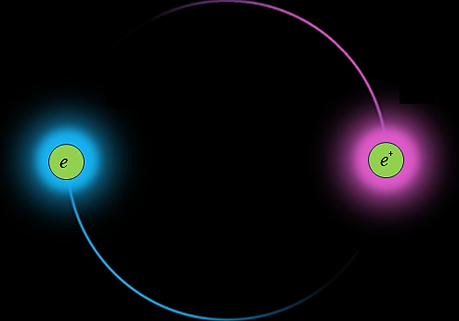
Figure 229 - Positronium (Ps)
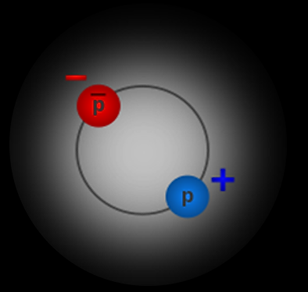
Figure 230 - Antiprotonic Hydrogen (Protonium)
Creation of positrons
Positrons, which are the antimatter counterparts of electrons, can be created through several processes in various settings, often involving high-energy phenomena. Here are some common methods for creating positrons:
Beta Plus Decay (Radioactive Decay):
One of the natural processes that produce positrons is beta plus decay. In certain radioactive isotopes, a proton in the nucleus is transformed into a neutron, and a positron and a neutrino are emitted. This process is common in isotopes with an excess of protons. An example is the decay of carbon-11 to boron-11:
Pair Production in High-Energy Photon Interactions:
When a high-energy photon interacts with matter, it can create an electron-positron pair. This phenomenon occurs in the vicinity of heavy atomic nuclei, and it's more likely at higher photon energies. The energy of the photon must be at least twice the rest mass energy of an electron (2mec2) to create the pair. The positron is the antimatter counterpart of the electron in this process.
Synchrotron Radiation:
In particle accelerators, especially those designed for high-energy physics research, electrons are accelerated to nearly the speed of light. When these high-energy electrons are deflected in magnetic fields, they emit synchrotron radiation. Occasionally, this radiation can convert into electron-positron pairs. The generated positrons can then be captured and used for various applications.
Positron Emission Tomography (PET):
Positron Emission Tomography (PET) is a medical imaging technique used to visualize and measure physiological processes in the body. The function of the positron in PET is central to its operation.
Positron Production
PET involves the use of a radioactive tracer, which typically consists of a biologically active molecule labeled with a positron-emitting radionuclide. Commonly used radionuclides for PET imaging include Fluorine-18 (¹⁸F), Carbon-11 (¹¹C), and Oxygen-15 (¹⁵O). For example Fluorine-18 decays by emitting a positron :
The emitted positron subsequently annihilates with an electron, producing two gamma-ray photons that can be detected and used to create detailed images of the distribution of the radioactive substance in the body.
Positron Annihilation
Once the radionuclide decays and emits a positron, the positron travels a very short distance (usually a few millimeters) before it interacts with an electron in the surrounding tissue. When a positron collides with an electron, they undergo annihilation, resulting in the simultaneous release of two high-energy photons (gamma rays) traveling in opposite directions.
Photon Detection
The gamma rays produced by positron-electron annihilation are detected by the PET scanner's detectors positioned around the patient. These detectors consist of scintillation crystals coupled with photodetectors. When a gamma ray interacts with the scintillation crystal, it produces flashes of light, which are then converted into electrical signals by the photodetectors.
Image Reconstruction
By detecting the pairs of gamma rays resulting from positron annihilation events, the PET scanner can reconstruct a three-dimensional image of the distribution of the radiotracer in the body. The intensity of the signals detected at different points in the body corresponds to the concentration of the radiotracer at those locations. This allows visualization and quantification of biological processes such as metabolism, blood flow, and receptor binding.
In practice, a patient undergoing a PET scan is administered the radiotracer, which is often tagged to a biologically active molecule such as glucose, water, or a neurotransmitter analog. The radiotracer is allowed to circulate and accumulate in the target tissue or organ of interest. The patient is then placed in the PET scanner, where the detectors capture the gamma rays emitted from positron annihilation events. The data collected by the detectors are processed to generate detailed images of the body's metabolic and physiological activity, aiding in diagnosis, staging, and monitoring of various diseases, including cancer, neurological disorders, and cardiovascular diseases.
Literature
-
Dale L. Bailey, David W. Townsend, et al. (2005) Positron emission tomography: basic sciences. Sringer [OLN B192]
-
Richard E. Carson, Peter Herscovitch, Margaret E. Daube-Witherspoon (1998) Quantitative Functional Brain Imaging with Positron Emission Tomography. Academic Press [OLN B193]
-
Jonas Francisco, Y. Santiago (2015) Positron Emission Tomography with Computed Tomography. Springer [OLN B189]
-
Anatoliy Granov, Leonid Tiutin, Thomas Schwarz (2013) Positron Emission Tomography. Springer [OLN B191]
-
K. Herholz, P. Herscovitch MD, W.-D. Heiss (2004) NeuroPET: Positron Emission Tomography in Neuroscience and Clinical Neurology. Springer [OLN B194]
-
P. Valk (2006) Positron Emission Tomography: Clinical Practice. Springer [OLN B190]
High-Energy Particle Colliders:
In particle physics experiments, high-energy colliders, such as the Large Hadron Collider (LHC) at CERN, can produce positrons through various processes. In these experiments, particles are accelerated to extremely high energies and collided, resulting in the production of various particles, including positrons.
It's important to note that while positrons can be created in these processes, they are short-lived and quickly annihilate upon encountering electrons, releasing energy in the form of gamma-ray photons. The controlled creation and manipulation of positrons are essential for both fundamental research in particle physics and practical applications such as medical imaging.
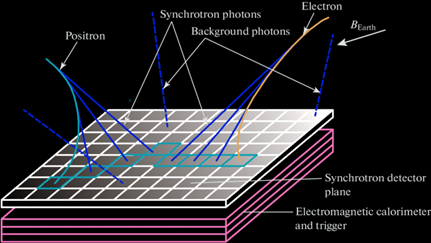
(018)

Figure 231 - Beta Plus Decay of Carbon-11

Figure 232 - Pair Production in High-Energy Photon Interaction
Figure 233 - Synchroton Radiation [1]
(14)
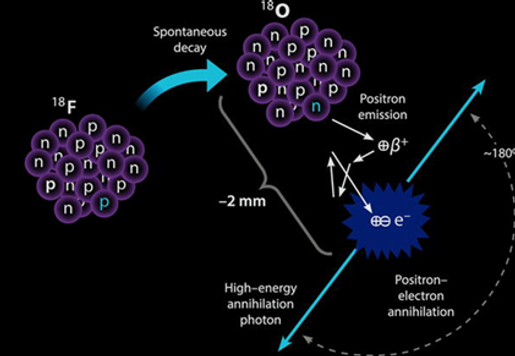
Figure 234 - Positron Emission Tomography (PET) [2]
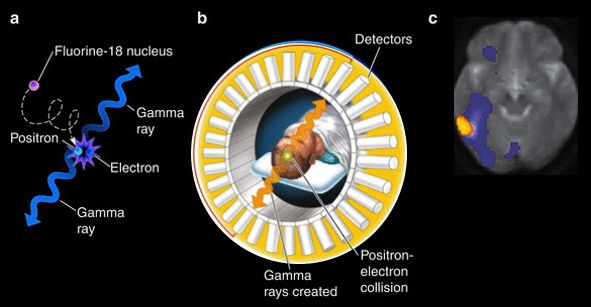
Figure 234a - PET scanner
Decay of positrons
A positron itself does not decay in the same way that unstable subatomic particles decay. The term "decay" is typically used to describe the transformation of one particle into others. In the case of a positron, it is an elementary particle, and under normal circumstances, it does not decay into other particles spontaneously.
However, positrons can undergo annihilation when they encounter an electron. In this process, the positron and electron annihilate each other, resulting in the creation of two gamma-ray photons. This annihilation process is not considered decay in the traditional sense but is a specific interaction between particles with opposite charges.
Fusion of positirons
Positron fusion is not a commonly recognized term, and it is not a process that occurs naturally or has a specific scientific meaning.
References
[1] Technique for Detecting High-Energy Electrons and Positrons by Means of Synchrotron Radiation in the Earth’s Magnetic Field. A. P. Stuzhin & V. V. Mikhailov. Physics of atomic nuclei. 86, pages522–527 (2023)
[2] PET-CT Imaging and Application. Computed-Tomography (CT) Scan. Sikandar Shaikh. (2022) DOI: 10.5772/intechopen.103975











